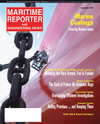
Page 34: of Maritime Reporter Magazine (September 2010)
Marine Propulsion Edition
Read this page in Pdf, Flash or Html5 edition of September 2010 Maritime Reporter Magazine
34 Maritime Reporter & Engineering News
British Columbia, on Canada’s west coast, has some attractive and well- proven tugs, but the fleet is aging with many vessels over thirty years old. Four years ago Vancouver’s Island Tug and
Barge (www.islandtug.com) launched the new build Island Scout with a pair of
Cummins KTA38 main engines.
This August, they will return their 1977-built 21 x 7.3-m tug Island De- fender to service. The midlife rebuild has taken a year to complete but as Island
Tug’s president Bob Shields explained this was much more than a repower, “As with our other Cummins repowers, we conducted a life cycle cost analysis using
Robert Allan Ltd. for assistance and de- termined that a package that included a pair of Cummins KT19s would yield us the best value. The engines are soft mounted and connected to the drive train via a Centa Link coupling which we ex- pect to have a tremendous impact on overall vessel noise as it did on the Island
Scout. We added a Krill fuel management and monitoring system, new shafts and
Kobelt shaft brakes, Rice nozzles and propellers and a pair of John Deere gensets. Most of the rest of the vessel has been re-built as well which has taken a little over a year to complete.”
Project manager Paul Kruse filled in some of the details of the extensive job as well as the pros and cons of such a re- build versus a new construction. “We had a good hull to start with,” he said. The Is- land Defender was built in Vancouver as the log-towing tug Hamilton Bailey with a pair of 480 HP Cat D346 mains. Later the boat was taken around to the Great
Lakes aboard a heavy lift ship. There she was renamed the Josee M and re-powered with a pair of Detroit DDEC V16-92 en- gines rated for 1100 HP each at 2100
RPM. Subsequently North Arm Trans- port brought her back to the Pacific coast before selling her to Island Tug. “A steel boats rusts from the inside out,” explains
Kruse, “It is easy to sand blast them and paint them all up nice on the outside but the inside is often neglected. But this boat had good steel through most of the boat.
We gutted the hull taking out all the pip- ing and repainting it with modern epoxy paints.”
That was just the start of the job. The fact that the hull had sponsons that act as mounts for the fendering and guards for the hull was an asset. Although use over the years had opened cracks in the steel that allowed salt water in, the main hull was well protected. The sponsons were opened up, blasted and painted inside then divided into four compartments be-
FEATURE MARINE PROPULSION
A Good Hull Deserves
A Good Rebuild by Alan Haig-Brown (Photo: Cour tesy of Island T ug and Bar ge Ltd.) INSET IMAGE: (Photo: Alan Haig-Br own cour tesy of Cummins Marine)
Owner ....................................Island Tug & Barge
Yard............................................Allied Shipyards
Main Engines ........................................Cummins
Naval Architect .........................Robert Allan Ltd.
Couplings.....................................................Centa
Gears ................................................................ZF
Nozzles ..........................................................Rice
Shaft brakes................................................Kobelt
Gensets................................................John Deere
Winches ....................................................Burrard

 33
33

 35
35
